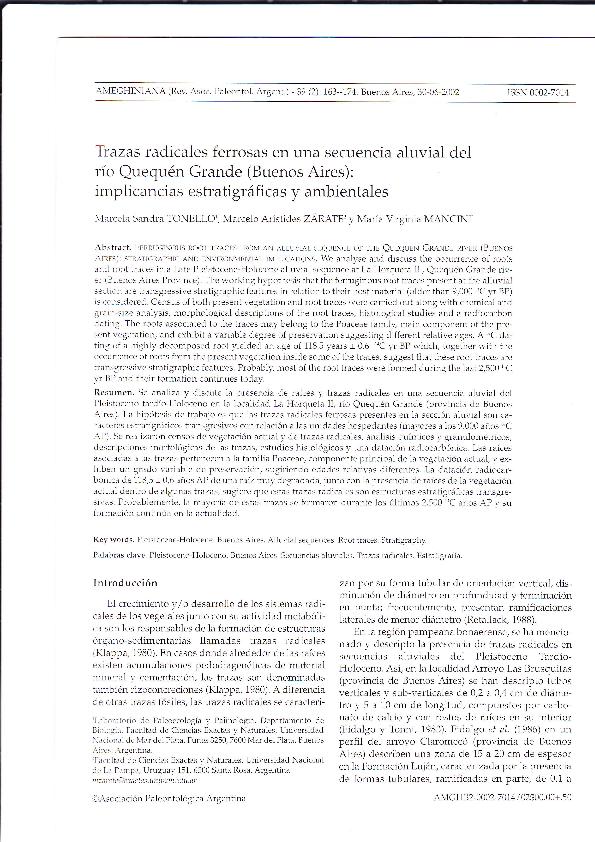Artículo
Se analiza y discute la presencia de raíces y trazas radicales en una secuencia aluvial del Pleistoceno tardío-Holoceno en la localidad La Horqueta II, río Quequén Grande (provincia de Buenos Aires). La hipótesis de trabajo es que las trazas radicales ferrosas presentes en la sección aluvial son caracteres estratigráficos transgresivos con relación a las unidades hospedantes (mayores a los 9.000 años 'rC AP). Se realizaron censos de vegetación actual y de trazas radicales, análisis químicos y granulométricos, descripciones morfológicas de las trazas, estudios histológicos y una datación radiocarbónica. Las raíces asociadas a las trazas pertenecen a la familia Poaceae, componente principal de la vegetación actual, y exhiben un grado variable de preservación, sugiriendo edades relativas diferentes. La datación radiocarbónica de 118,5 + 0,6 años AP de una raíz rnuy degradada, junto con la presencia de raíces de la vegetación actual dentro de algunas trazas, sugiere que estas trazas radicales son estructuras estratigráficas transgresivas. Probablemente, la mayoría de estas trazas se formaron durante los últimos 2.500 14C años AP y su formación continúa en la actualidad. We analyse and discuss the occurrence of roots and root traces in a Late Pleistocene-Holocene alluvial sequence at La Horqueta II, Quequén Grande river (Buenos Aires Province). The working hypothesis that the ferruginous root traces present at the alluvial section are transgressive stratigraphic features in relation to their host material (older than 9,000 14Cyr BP) is considered. Census of both present vegetation and root traces were carried out along with chemical and grain-size analysis, morphological descriptions of the root traces, histological studies and a radiocarbon dating. The roots associated to the traces may belong to the Poaceae family, main component of the present vegetation, and exhibit a variable degree of preservation suggesting different relative ages. A I'C dating of a highly decomposed root yielded an age of 118.5 years ± 0.6 I'C yr BP which, together with the occurrence of roots from the present vegetation inside some of the traces, suggest that these root traces are transgressive stratigraphic features. Probably, most of the root traces were formed during the last 2,500 I'C yr BP and their formation continues today.
Trazas radicales ferrosas en una secuencia aluvial del río Quequén Grande (Buenos Aires): implicancias estratigráficas y ambientales
Título:
Ferrugionous roor traces from an alluvial sequence of the Qureuen Grande river (Buenos Aires): stratigraphic and environmental implications
Fecha de publicación:
12/2002
Editorial:
Asociacion Paleontologica Argentina
Revista:
Ameghiniana
ISSN:
0002-7014
e-ISSN:
1851-8044
Idioma:
Español
Tipo de recurso:
Artículo publicado
Clasificación temática:
Resumen
Archivos asociados
Licencia
Identificadores
Colecciones
Articulos(INCITAP)
Articulos de INST.D/CS D/L/TIERRA Y AMBIENTALES D/L/PAMPA
Articulos de INST.D/CS D/L/TIERRA Y AMBIENTALES D/L/PAMPA
Citación
Tonello, Marcela Sandra; Zárate, Marcelo Arístides; Mancini, Maria Virginia; Trazas radicales ferrosas en una secuencia aluvial del río Quequén Grande (Buenos Aires): implicancias estratigráficas y ambientales; Asociacion Paleontologica Argentina; Ameghiniana; 39; 2; 12-2002; 163-174
Compartir




